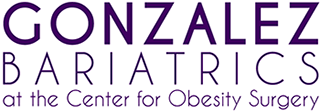Obesity Surgery
Laparoscopic Adjustable Gastric Banding
The LAP-BAND Adjustable Gastric Banding System is the most revolutionary surgical treatment for morbid obesity in the United States. It induces weight loss by reducing the capacity of the stomach, thereby restricting the amount of food that can be consumed at one time. This simple yet effective bariatric procedure helps patients gradually lose weight and keep it off! The term “lap band” is often mistakenly referred to as the generic name for any stomach banding weight loss procedure, however, LAP-BAND is the registered trademark for the original FDA approved adjustable gastric banding device manufactured and sold by Allergan, Inc. of Irvine, CA.
Like a wristwatch, the band is fastened around the upper stomach to create a new, tiny stomach pouch. As a result, patients experience an earlier sensation of fullness and are satisfied with smaller amounts of food. Since there is no cutting, stapling, or stomach rerouting involved in the LAP-BAND System procedure, it is considered the least traumatic of all weight loss surgeries. The surgeon makes several tiny incisions and uses long, slender instruments to implant the device. By avoiding the large incision of open surgery, patients generally experience less pain and scarring. In addition, the hospital stay is shortened to less than 24 hours, including overnight hospitalization. Patients can typically resume normal activities within 1 week, which is considerably quicker than with other surgical weight loss alternatives.
The LAP-BAND System is an adjustable silicone band with an inflatable inner surface. It is connected to an access port below the skin surface by thin, kink-resistant silicone tubing. The port allows the bariatric surgeon to adjust the size of the LAP-BAND System to meet individual patient weight loss needs by adding or removing saline to inflate or deflate the band. This impacts the amount and consumption rate of food. Adjustments to the band, which are performed during simple outpatient visits, are determined by the patient’s weight loss, the amount of food that can be comfortably eaten, the exercise regimen, and other issues surrounding the patient’s health, as well as the amount of fluid already in the patient’s band.
Because there are no permanent changes made to the body’s physiology, the banding procedure can essentially be reversed. If necessary, all of the system components can be removed from the body with no damage to the digestive organs. The stomach will generally return to its original form and capacity once the band is removed.
The effectiveness of the LAP-BAND System depends on the success of the surgical procedure and the ability of the patient to change his or her diet and eating behavior. Clinicians offering the LAP-BAND System treatment have committed to being able to provide long-term care for their patients, including dietary, behavior-modification, and counseling support. After surgery, LAP-BAND System patients must maintain scheduled follow-up visits. Follow-up may require twelve or more visits during the first year and include a review of the patient’s progress and discussion of any concerns or problems that are pertinent at that time. Patients are encouraged to eat a balanced diet and to avoid the problematic eating patterns of their pre-surgery lifestyle. The restrictive effect of the band produces feelings of early satiety and longer-lasting fullness. This reinforces the patient’s ability to be content with smaller meals when solid food is eaten and well chewed. At the appropriate time, patients are encouraged to increase physical activity and exercise, which is very important to weight loss, good health, and improved quality of life.
Since the Food and Drug Administration’s approval of the LAP-BAND System in June 2001, interest in and use of the LAP-BAND System have been rapidly growing in the U.S. In line with its FDA-approved guidelines for indications, the LAP-BAND System is intended for people who are morbidly obese, those who are at least 100 pounds overweight or who are at least twice their ideal body weight. The term “morbidly” connotes the fact that individuals who carry this much excess weight face an increased risk of developing a number of serious health conditions, including diabetes, high blood pressure, cardiovascular disease, cancer, and osteoarthritis.
In February 2002, a report released by the United States Food and Drug Administration Office of Device Evaluation named the LAP-BAND System as one of the Significant Device Breakthroughs. The Office of Device Evaluation highlighted the LAP-BAND System with several other new products as significant medical breakthroughs, as they are first of a kind, e.g., they use a new technology or provide a major diagnostic or therapeutic advancement, such as reducing hospital stays and replacing the need for surgical intervention.
Find out more about Laparoscopic Adjustable Gastric Banding with the following links.
Roux-en-y Gastric Bypass
The Roux en-y Gastric Bypass, is considered the “gold standard” of modern obesity surgery. This operation achieves its effects by creating a very small (around 1 ounce) stomach pouch from which the rest of the stomach is permanently divided and separated. The small intestine is cut about 18 inches below the stomach, and is arranged to provide an outlet to the small stomach, while maintaining the flow of digestive juices at the same time. The lower part of the stomach is bypassed, and food enters the second part of the small bowel. The operation works by reducing food intake, and reducing the feeling of hunger. The result is a very early sense of fullness, followed by a very profound sense of satisfaction. Even though the portion size may be small, there is no hunger, and no feeling of having been deprived. Most patients will experience “dumping syndrome” when they eat sweets. “Dumping syndrome” causes the patient to have crampy abdominal pain, feel faint and have diarrhea. A portion of the small bowel is bypassed causing malabsorption, which leads to more weight loss. Patients feel indifferent to even the choicest of foods.
The Gastric Bypass provides an excellent tool for gaining long-term control of weight, without the hunger or craving usually associated with small portions, or with dieting. Weight loss of 80 – 100% of excess body weight is achievable for most patients, and long-term maintenance of weight loss is very successful. It does, however, require adherence to a simple and straightforward behavioral plan.
Laparoscopic or Open refers to the “approach” – it is still the RNY gastric bypass.
Laparoscopic Roux-en-y Gastric Bypass
The purpose of this approach is to have the same surgical procedure with as little discomfort to the patient as possible and to also decrease the chances of some complications.
Laparoscopic surgery allows surgeons to “see” into the abdomen using a pencil-thin optical telescope, and to project the picture from the video camera on a TV monitor at the head of the operating table. The surgeon has to develop skills in operating without being able to feel tissue directly, and by learning to determine where instruments are by seeing them on TV.
The benefits of the laparoscopic approach come from the 5-6 very small ¼ to ½ inch incisions which are made. With laparoscopic surgery there is much less pain and very little scarring. Patients are better able to get up and walk within hours after surgery, can breath easier, and move without discomfort. Bowel activity usually is not affected, as it is with an open incision. Most patients find they can return to normal activities within a much shorter time. People experience similar weight loss and less overall complications.
The anatomic visualization is actually better through the scope than in the open operation. The risks of surgery performed laparoscopically are comparable the “open” procedure. To summarize the advantages of the laparoscopic approach: there is less pain, cosmetic improvement, decreased time in the hospital, shorter recuperation, decrease of some possible complications (wound infection, wound hernias, and pulmonary problems), is cost efficient and maintains the same successful results reported around the world with the open bypass procedure.
Find out more about Gastric Bypass with the following links.
Sleeve Gastrectomy
This is a relatively new approach. It is the first component of the duodenal switch operation and involves removing the lateral 2/3rds of the stomach with a stapling device. It can be done laparoscopically ( keyhole surgery) but is not reversible. It basically leaves a stomach tube instead of a stomach sack.

















